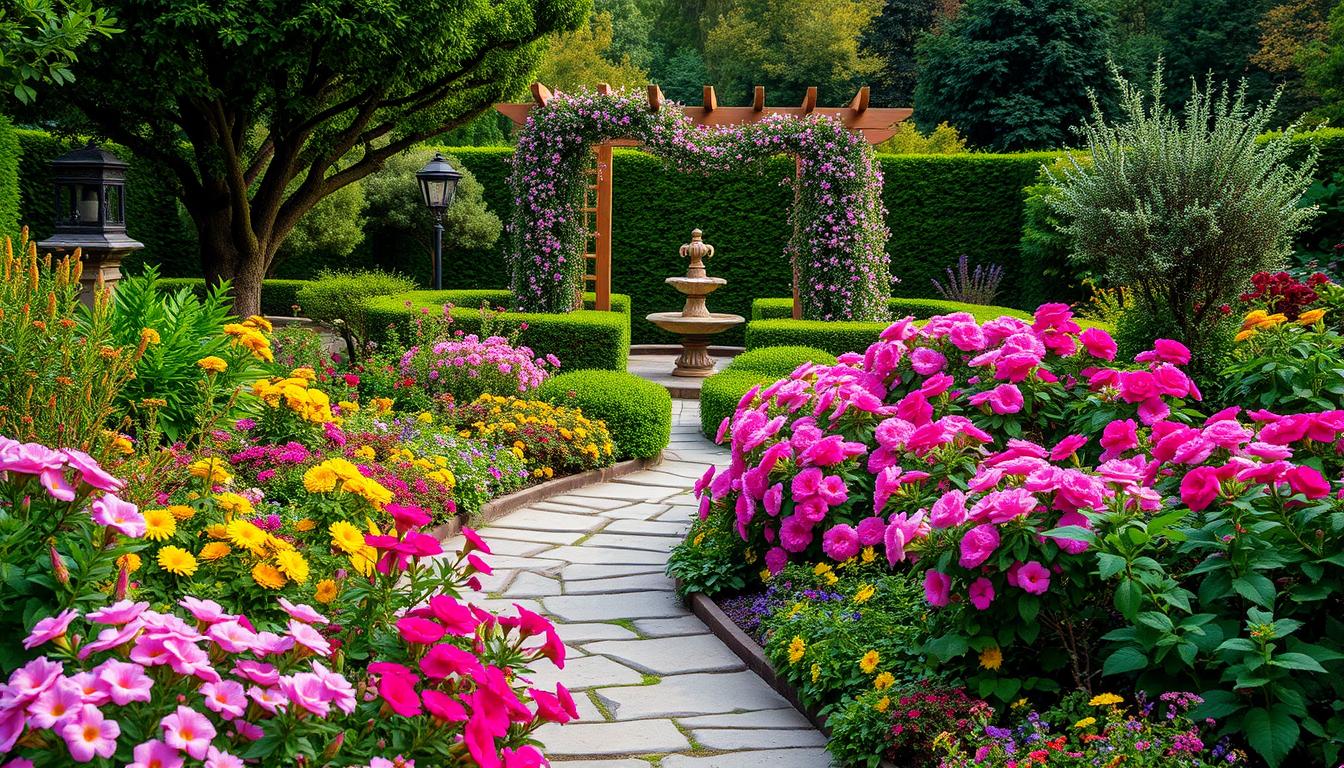Looking to breathe new life into your outdoor space? Whether you have a sprawling yard or a cozy corner, there are countless ways to make it shine. From raised beds to trellises, these garden planning design ideas can help you create a space that’s both beautiful and functional.
For those with limited space, vertical designs and companion planting can maximize every inch. If you’re dealing with poor soil, raised beds offer a practical solution. And for those who love variety, styles range from charming cottage layouts to sleek modern homesteads.
Drought-resistant plants and pollinator-friendly options are perfect for eco-conscious gardeners. Plus, we’ve included tips tailored to USDA growing zones, ensuring your efforts thrive in your local climate. Whether you’re a beginner or a seasoned pro, these ideas are designed to inspire and guide you every step of the way.
Key Takeaways
- Discover 20 creative ways to transform any outdoor space.
- Learn practical solutions for challenges like limited space or poor soil.
- Explore diverse styles, from cottage layouts to modern designs.
- Incorporate eco-friendly options like drought-resistant plants.
- Get tips tailored to USDA growing zones for better results.
1. Square-Foot Gardening Layouts
Make the most of your space with a method that’s both simple and effective. Square-foot gardening is a structured approach that uses 4×4-foot raised boxes divided into 1’x1′ grids. This layout allows you to grow a variety of vegetables, herbs, and even dwarf fruit trees in a compact area.
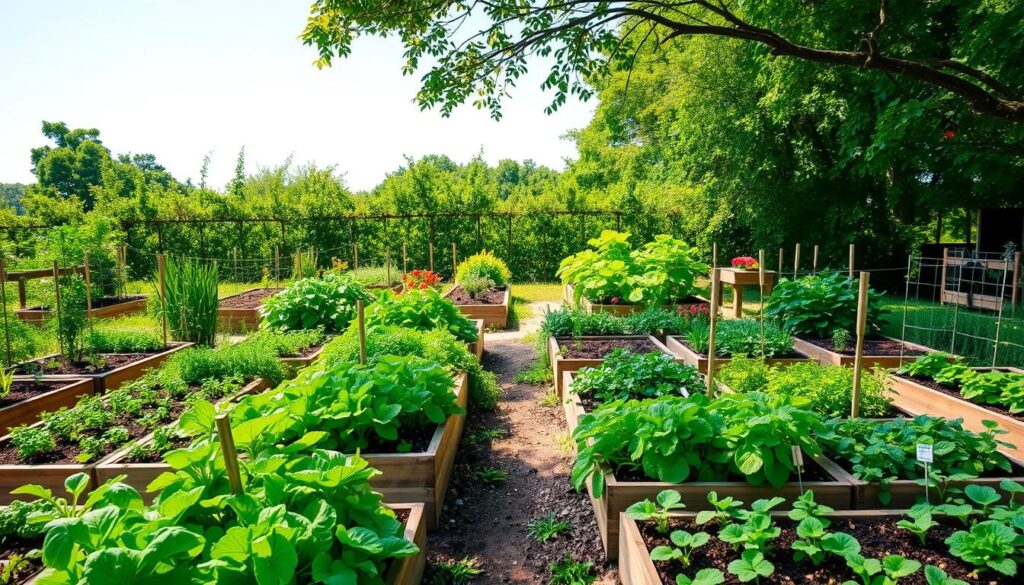
Maximize Space with Efficient Planting
This method is perfect for urban gardeners or anyone with limited space. By planting densely in each grid, you can achieve multiple harvests throughout the season. The mathematical precision of the 1’x1′ grids ensures every inch is used efficiently, reducing wasted space and maximizing yield.
Benefits of Square-Foot Gardening
One of the biggest advantages is the significant reduction in weeding—up to 80% compared to traditional row gardening. The soil mix, made of 1/3 peat moss, 1/3 vermiculite, and 1/3 compost, provides optimal conditions for plant growth. This system is also beginner-friendly, with detailed spacing guides to help you get started.
Top crops for this method include lettuce, radishes, carrots, and herbs. For those looking to add vertical elements, dwarf fruit trees can be integrated into the raised beds. Maintenance is straightforward, with tips like regular watering and harvesting ensuring continuous productivity.
| Method | Yield per Square Foot | Weeding Required |
|---|---|---|
| Square-Foot Gardening | High | Low |
| Traditional Row Gardening | Moderate | High |
A case study highlights how a 100-square-foot setup can feed a family of four. This method not only saves space but also promotes sustainable living by reducing waste and encouraging homegrown produce.
2. Backyard Garden Layouts
Transform your backyard into a versatile space that meets both family and gardening needs. With 63% of American families seeking multipurpose outdoor areas, blending functionality with beauty is key. Whether you’re growing a vegetable garden or creating a play zone, thoughtful design ensures everyone enjoys the space.
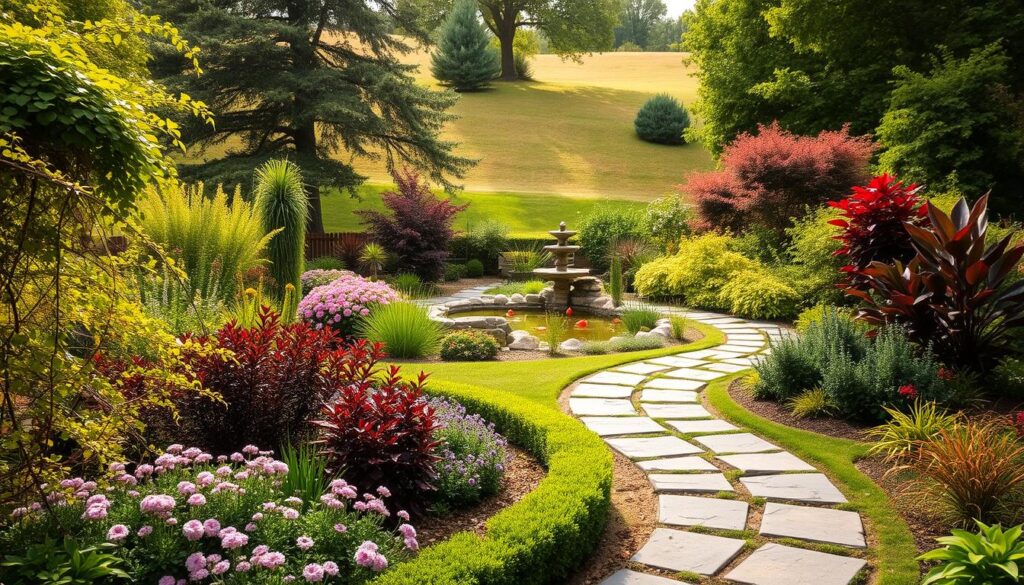
Balancing Family Needs and Gardening
Start by designating zones using natural barriers like lavender hedges or decorative fencing. This keeps play areas separate from your plants while maintaining a cohesive look. Durable groundcovers, such as clover, work well between raised beds, offering a soft surface for kids and pets.
Include kid-friendly features like sunflower houses or strawberry towers to make the space engaging. For pet owners, opt for non-toxic mulches and dog-resistant plants like rosemary, thyme, and hot peppers. Scheduling planting around family events ensures your vegetable garden thrives without disrupting daily life.
Protecting Plants from Play Areas
Use durable edging materials like steel, stone, or composite to define spaces and protect your plants. Slip-resistant paving near pools or patios adds safety while complementing the overall design. These small touches ensure your backyard remains both functional and stylish.
By thoughtfully balancing family activities and gardening, you can create a space that everyone loves. From practical solutions to creative touches, your outdoor area can become a true extension of your home.
3. Raised Bed Garden Layouts
Elevate your outdoor experience with a solution that’s both practical and stylish. Raised beds are an excellent choice for tackling challenging soil conditions or creating a more accessible space for gardening. Whether you’re growing vegetables or ornamental plants, this method offers flexibility and efficiency.

Ideal for Difficult Soils
If your yard has poor drainage or compacted soil, raised beds provide a quick fix. By filling them with a custom soil mix, you can create the perfect environment for your plants. Cedar or composite boards are ideal materials, ensuring durability and longevity.
Compared to traditional soil amendments, installing raised beds can be more cost-effective in the long run. They also reduce the need for constant tilling and weeding, saving you time and effort.
Accessibility for Gardeners with Limited Mobility
For those with limited mobility, raised beds offer a game-changing solution. A height of 28″ is ideal for wheelchair access, while a width of 4′ allows easy reach from both sides. ADA-compliant pathways, with a minimum width of 36″, ensure smooth navigation around the space.
Vertical irrigation systems and ergonomic tools, like extended reach pruners, make maintenance easier. These features are especially beneficial for seniors or individuals with physical challenges.
| Feature | Benefit |
|---|---|
| Custom Soil Mix | Optimal plant growth |
| 28″ Height | Wheelchair accessibility |
| 4′ Width | Easy reach from both sides |
Best crops for raised beds include salad greens, bush beans, and herbs. These plants thrive in the controlled environment and are easy to harvest. A senior community garden project in Oregon successfully implemented these techniques, proving that raised beds can bring people together while promoting healthy living.
4. Kitchen Garden Layouts (Potager)
Create a vibrant and productive space right outside your door with a kitchen garden. This approach blends vegetables, herbs, and flowers into a functional and beautiful layout. Perfect for USDA zones 5-8, it ensures a steady supply of fresh produce throughout the season.
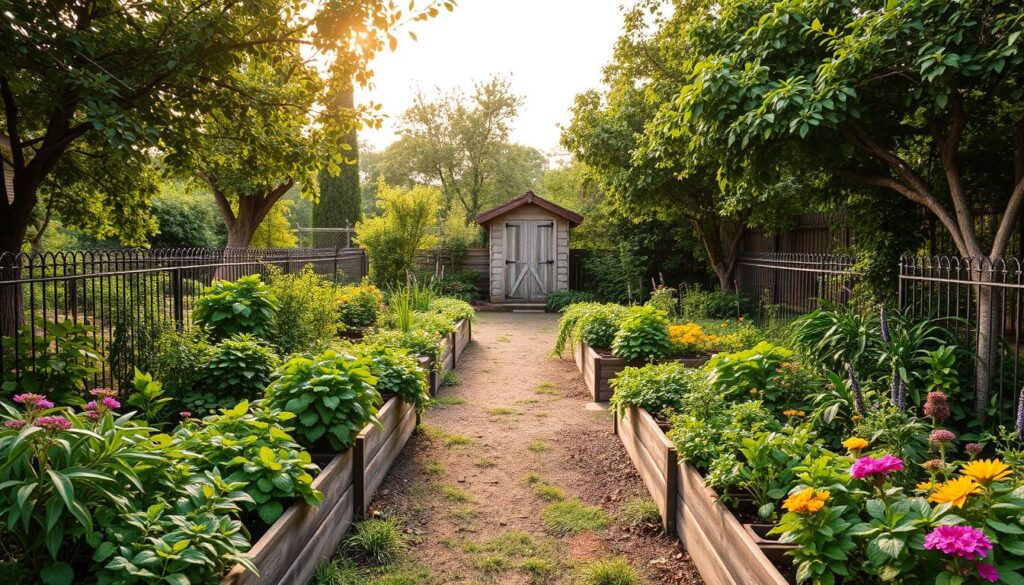
Blending Vegetables, Herbs, and Flowers
A kitchen garden thrives on diversity. Companion planting with marigolds, nasturtiums, and calendula not only adds color but also deters pests naturally. Aromatic herbs like basil and rosemary can be strategically placed to protect your vegetables.
Decorative elements, such as obelisk trellises and painted stakes, add charm while supporting climbing plants. This blend of practicality and beauty makes your outdoor space both functional and inviting.
Continuous Supply of Fresh Produce
Succession planting is key to maintaining a steady harvest. Quick-growing crops like radishes and lettuce can be planted between main crops to maximize space. “Cut-and-come-again” varieties, such as kale and Swiss chard, ensure a continuous supply of fresh greens.
For a 10’x10′ plot, a sample weekly harvest calendar might include:
- Week 1: Lettuce, spinach, and radishes
- Week 4: Bush beans and herbs
- Week 8: Tomatoes and peppers
With an average yield of 1lb per square foot annually, a well-planned kitchen garden can be both productive and sustainable. For more tips on starting your own, check out this guide on gardening for beginners.
5. Homestead Garden
A homestead garden offers a path to independence and sustainability. It’s more than just growing food—it’s about creating a self-reliant lifestyle. With the right approach, you can feed your family and even generate income through market gardening.
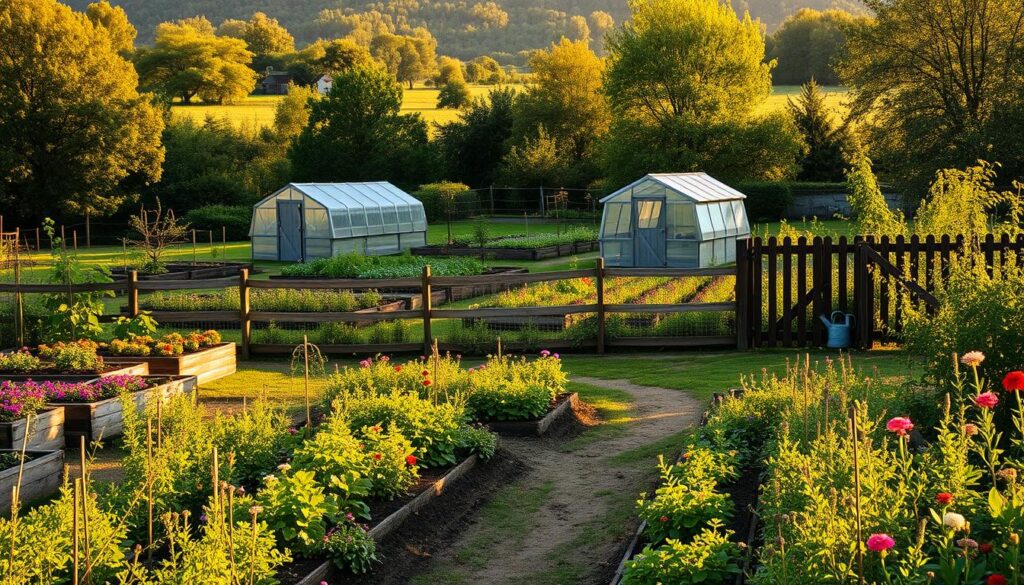
Self-Sufficiency and Market Gardening
One of the main goals of a homestead garden is achieving self-sufficiency. A quarter-acre plot can provide enough vegetables to feed a family of four, with surplus for preserving or selling. Common crops include potatoes, winter squash, and drying beans.
Incorporating chicken tractors can help with pest control while providing fresh eggs. This dual-purpose approach maximizes productivity and reduces waste. For those interested in market gardening, focusing on high-demand crops like salad greens and herbs can yield significant profits.
Traditional In-Ground Rows
Traditional in-ground rows are a staple of homesteading. This method is cost-effective and works well for large-scale cultivation. Crop rotation over a 7-year cycle helps maintain soil health and prevent pest buildup.
Essential tools for this approach include a broadfork, hoe, and wheelbarrow. Rainwater harvesting systems can further enhance sustainability by reducing reliance on external water sources.
| Feature | Heirloom Varieties | Hybrid Varieties |
|---|---|---|
| Seed Saving | Yes | No |
| Disease Resistance | Low | High |
| Flavor | Rich | Consistent |
Profit margins for common market crops can vary. For example, salad greens often yield $10-$15 per square foot annually. An interview with a successful urban homesteader revealed that diversifying crops and focusing on niche markets can significantly boost income.
By combining traditional methods with modern techniques, a homestead garden can be both productive and rewarding. Whether you’re aiming for self-sufficiency or exploring market gardening, this approach offers endless possibilities.
6. Small Gardens
Limited space doesn’t mean limited possibilities for your outdoor area. With a few smart strategies, you can turn even the tiniest spots into productive and beautiful spaces. Whether you’re working with a balcony, patio, or a small corner, these tips will help you make the most of your small space.
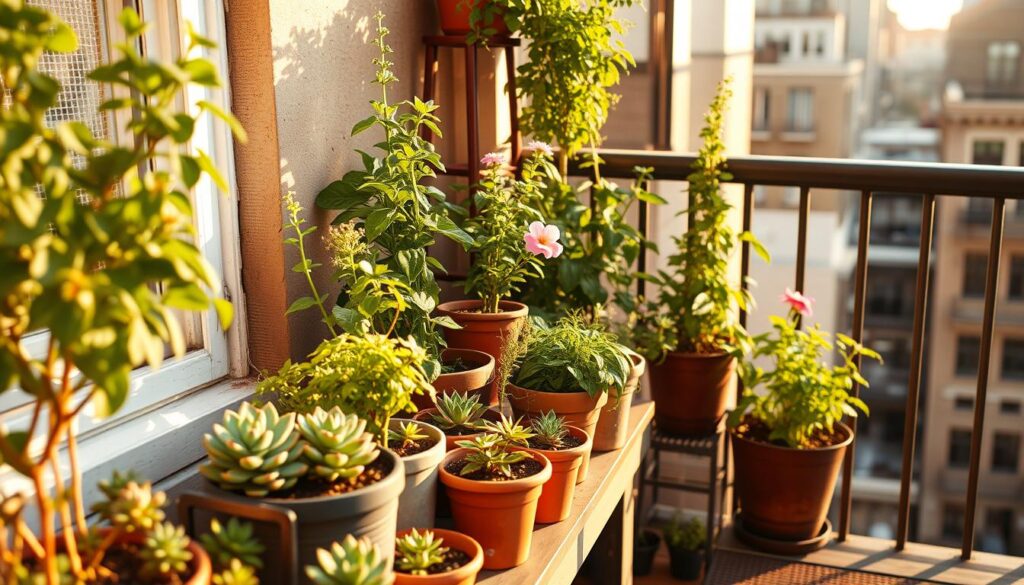
Maximizing Limited Space
Vertical gardening is a game-changer for small areas. By using trellises, wall planters, or hanging baskets, you can increase your yield by up to 93%. Top space-efficient crops include tomatoes, pole beans, and cucumbers, which thrive when grown vertically.
Fold-down balcony planters are another great option for tight spaces. They’re easy to install and can be folded up when not in use. For patios, edible container varieties like microgreens and specialty herbs are perfect. These plants are compact, high-value, and easy to care for.
Prioritizing Crops You Love
When space is limited, focus on growing what you love to eat or use. A window box herb garden is a simple way to add fresh flavors to your meals. Interplanting strategies, like pairing radishes with carrots, can also maximize your harvest in a small area.
Here’s a 4-season plan for a 4’x4′ balcony garden:
- Spring: Lettuce, spinach, and radishes
- Summer: Tomatoes, basil, and peppers
- Fall: Kale, Swiss chard, and carrots
- Winter: Microgreens and herbs
| Crop | Space Required | Yield |
|---|---|---|
| Tomatoes | 1 sq. ft. | High |
| Pole Beans | 1 sq. ft. | Moderate |
| Cucumbers | 2 sq. ft. | High |
With these tips, you can transform your small space into a thriving and enjoyable area. Whether you’re growing food or creating a green retreat, the possibilities are endless.
7. Dry Gardens or Drought-Resistant Gardens
Transform your outdoor area into a resilient and eco-friendly space with dry gardens. These setups are perfect for regions with limited water resources or those looking to reduce their environmental impact. By focusing on water-efficient techniques and native plants, you can create a thriving space that’s both beautiful and sustainable.

Water-Efficient Gardening Techniques
One of the most effective ways to conserve water is through drip irrigation. This system reduces water use by up to 50% compared to traditional methods. Another innovative solution is the use of ollas, clay pots buried in the soil that slowly release water to plant roots. These methods ensure your plants get the moisture they need without waste.
Xeriscaping principles are also key to creating a dry garden. This approach involves using drought-tolerant plants, such as okra, Swiss chard, and peppers, which thrive in arid conditions. Native plants are particularly well-suited to your local climate, requiring less maintenance and water.
Companion Planting and Mulching
Companion planting is a natural way to enhance your garden’s health. Pairing plants like marigolds with vegetables can deter pests and improve growth. Additionally, mulching with straw, wood chips, or gravel helps retain soil moisture and regulate temperature. These practices not only conserve water but also reduce the need for chemical fertilizers.
For fire-prone areas, fire-wise landscaping is essential. Use non-flammable materials like gravel and stone, and space plants strategically to reduce fire risk. A case study from the Southwest highlights how these techniques can create a stunning and safe outdoor space.
By adopting these strategies, you can build a dry garden that’s both functional and environmentally conscious. Whether you’re in a dry region or simply want to save water, these tips will help you create a sustainable outdoor area.
8. Flower Garden
Bring a burst of color and life to your outdoor area with a flower-focused approach. Whether you’re aiming for a serene retreat or a vibrant display, flowers can transform any space into a beautiful and relaxing haven. From attracting pollinators to creating sensory experiences, there’s so much to explore.
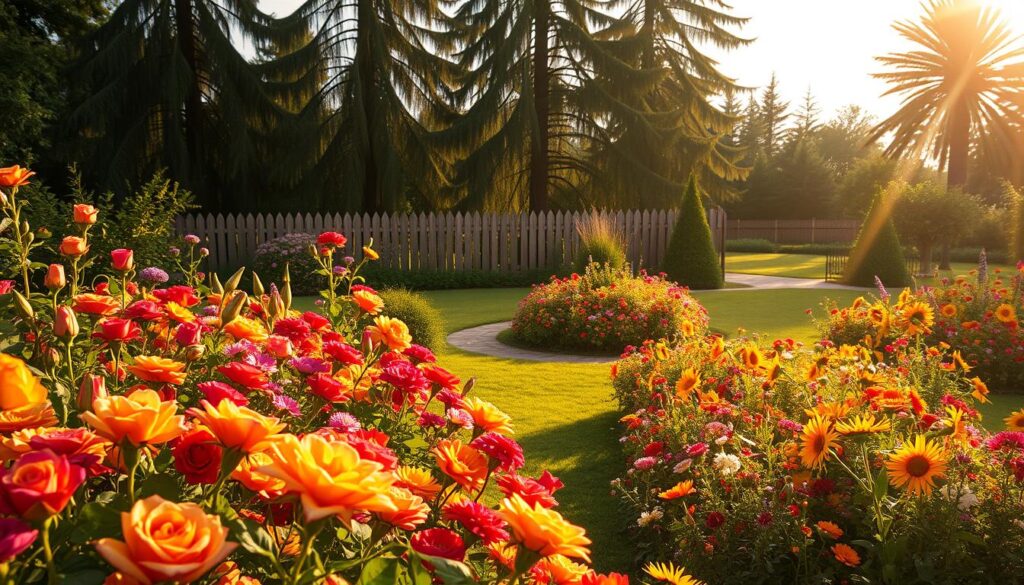
Enhancing Beauty and Relaxation
Flowers are more than just pretty—they can elevate your mood and create a calming atmosphere. Consider designing color-themed areas to evoke specific emotions. For example, cool blues and purples promote relaxation, while warm reds and yellows energize the space.
Fragrant varieties like lavender, jasmine, and roses add an extra layer of enjoyment, especially in the evenings. To ensure continuous blooms, plan a sequence of flowering plants. Start with early bloomers like tulips, followed by summer favorites like zinnias, and end with fall stars like chrysanthemums.
Attracting Beneficial Insects
Did you know that 75% of crops rely on pollination? By planting flowers like cosmos, zinnias, and sunflowers, you can attract bees, butterflies, and other pollinators. These insects not only help your plants thrive but also contribute to a healthier ecosystem.
Natural pest control is another benefit. Pairing marigolds with vegetables can deter harmful insects, while nasturtiums act as a trap crop for aphids. This combination creates a balanced and thriving environment.
- Design color-themed areas for visual harmony.
- Include fragrant varieties for evening enjoyment.
- Plant pollinator-friendly flowers to support ecosystems.
- Use companion planting for natural pest control.
With thoughtful design, your flower-focused space can be both beautiful and functional. Whether you’re creating a cutting garden or a sensory retreat, the possibilities are endless.
9. Companion Planting Garden
Boost your outdoor space with a natural and efficient gardening method. Companion planting is a time-tested technique that pairs plants to enhance growth, deter pests, and improve yields. By understanding which plants thrive together, you can create a harmonious and productive ecosystem.
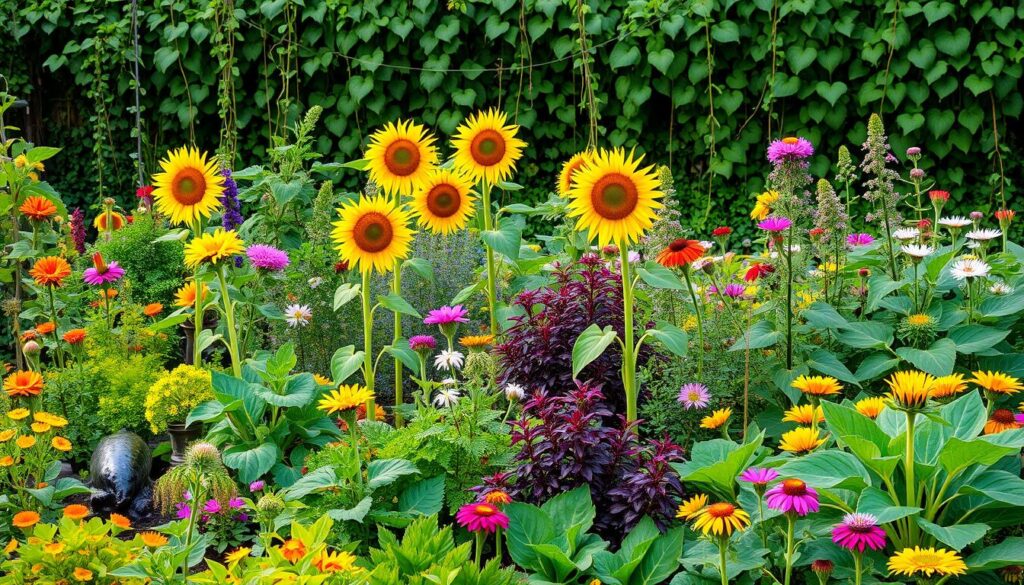
Natural Pest Protection
One of the biggest benefits of companion planting is its ability to naturally protect your plants. For example, marigolds repel nematodes, while basil improves the flavor and growth of tomatoes. These pairings reduce the need for chemical pesticides, making your space healthier and more sustainable.
Here are some effective plant combinations for pest protection:
- Marigolds with tomatoes to deter nematodes.
- Basil with peppers to repel aphids and whiteflies.
- Nasturtiums with cucumbers to act as a trap crop for aphids.
Supporting Plant Growth
Certain plants can boost the growth of their neighbors. For instance, nitrogen-fixing plants like beans enrich the soil, benefiting heavy feeders like corn. The classic three-sister planting method combines corn, beans, and squash to create a mutually supportive trio.
Other ways to support plant growth include:
- Pairing carrots with onions to deter carrot flies.
- Planting radishes with spinach to maximize space and yield.
- Using allelopathic plants like sunflowers to suppress weeds.
For optimal results, consider following a biodynamic planting calendar. This approach aligns planting activities with lunar cycles, enhancing the health and productivity of your vegetables.
10. Partial-Shade Gardens
Shaded spots in your yard can be transformed into thriving green spaces. With the right approach, you can grow vegetables and plants even in areas with limited sunlight. Whether you’re dealing with a north-facing layout or a woodland-inspired space, partial-shade gardening offers endless possibilities.
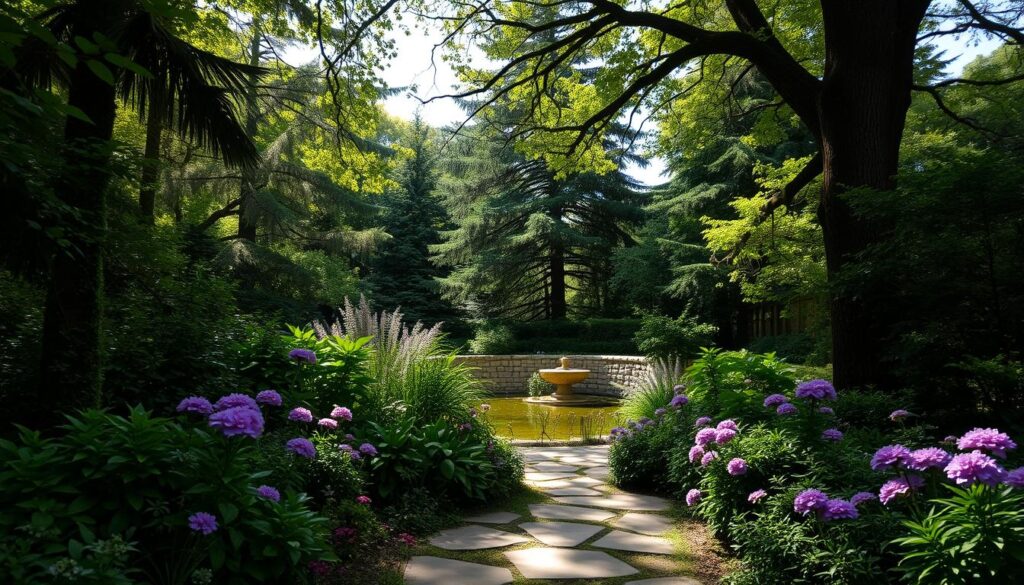
Growing Vegetables in Shade
Did you know leafy greens like kale and spinach only need about 4 hours of sunlight daily? These vegetables are perfect for shaded areas. Other performers include mint, which thrives in low-light conditions, and Swiss chard, which adds color and nutrition to your space.
To maximize light, consider using reflective surfaces like white walls or mirrors. Smartphone apps can help you measure light levels and identify the best spots for planting. For deep shade, edible mushrooms like shiitake or oyster varieties are an excellent choice.
Shade-Tolerant Plants
When selecting plants, focus on those that naturally adapt to partial shade. Hostas, ferns, and astilbes are popular for their lush foliage and low maintenance. For a touch of elegance, try espalier fruit tree training, which works well in shaded areas.
Here’s a quick guide to shade-tolerant options:
- Leafy Greens: Kale, spinach, and lettuce.
- Herbs: Mint, parsley, and cilantro.
- Flowers: Impatiens, begonias, and foxgloves.
| Plant Type | Light Requirement | Best Use |
|---|---|---|
| Kale | Partial Shade | Edible Greens |
| Mint | Low Light | Herb Garden |
| Hostas | Full Shade | Ornamental |
For more inspiration on transforming shaded spaces, check out these boho yard decor ideas. With a little creativity, your shaded areas can become some of the most beautiful and productive parts of your outdoor space.
11. Trellises in Garden Design
Maximize your outdoor area’s potential with a simple yet effective vertical solution. Trellises are a game-changer for supporting vining plants and increasing your growing space. Whether you’re cultivating cucumbers, beans, or decorative climbers, these structures can boost your yield by up to 400%.
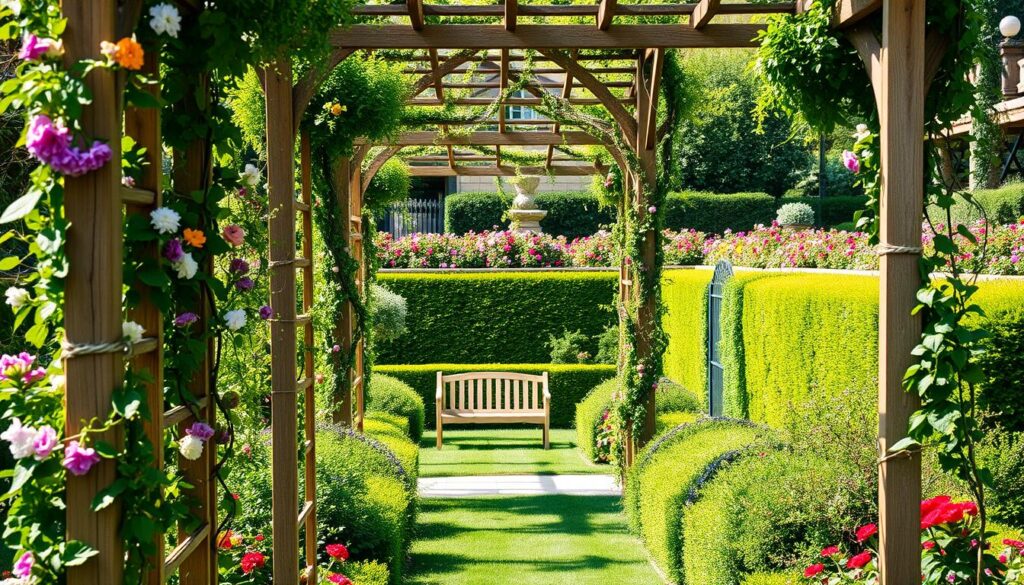
Supporting Vining Plants
Vining plants like tomatoes, peas, and squash thrive when given proper support. Trellises not only keep these plants off the ground but also improve air circulation, reducing the risk of disease. For heavy-duty options, consider cattle panels or cedar frames, which are durable and long-lasting.
Training annual vines is simple. Start by gently tying young shoots to the trellis with soft twine. As they grow, guide them upward to encourage vertical growth. This technique works well for both edible and ornamental plants.
Increasing Growing Space
Vertical gardening is perfect for small areas. By using trellises, you can grow more vegetables in less space. Popular trellis types include obelisks, arches, and A-frames, each offering unique benefits. For example, A-frames are ideal for sprawling plants like pumpkins, while obelisks add a decorative touch to your layout.
Here are some edible screen plant combinations to try:
- Beans and nasturtiums for a vibrant, pest-resistant display.
- Cucumbers and morning glories for a lush, green wall.
- Peas and sweet peas for a fragrant and productive setup.
For a DIY project, consider building a pallet trellis. It’s cost-effective, eco-friendly, and customizable to fit your space. During winter, decorate your trellises with fairy lights or evergreen garlands to keep your outdoor area inviting year-round.
12. Large Backyard Garden Layouts
Unlock the full potential of your spacious outdoor area with creative and functional ideas. A large backyard offers endless possibilities, from meadow-inspired landscapes to formal parterres. Whether you’re aiming for a low-maintenance setup or a stunning focal point, the right layout can transform your space into a personal retreat.
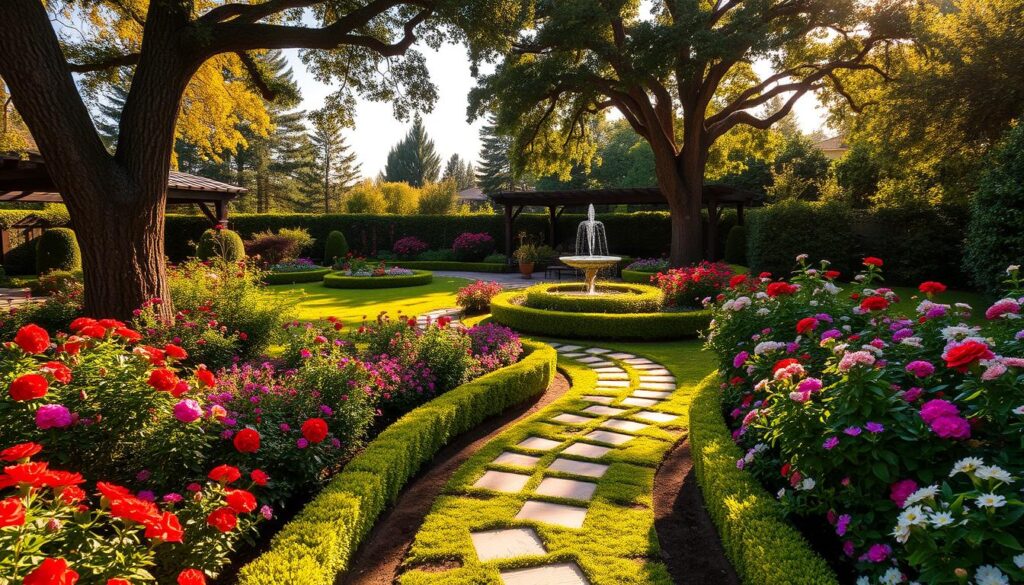
Choosing the Right Layout
When planning your large backyard, consider your lifestyle and goals. Meadow gardens are a great option for those seeking a natural look. They reduce mowing by 70% and attract pollinators. For a more structured approach, formal parterres can increase property value by 15% while adding elegance to your landscape.
Here’s a quick comparison of popular styles:
- French Potager: Combines vegetables, herbs, and flowers in geometric patterns.
- English Cottage: Features a mix of colorful blooms and relaxed, informal borders.
For added functionality, integrate an outdoor kitchen. This creates a seamless transition between cooking and entertaining. Focal points like gazebos or water features can also enhance the overall appeal of your space.
Inspiring Garden Designs
Looking for inspiration? Consider a permaculture food forest. This layered approach mimics natural ecosystems, with trees, shrubs, and groundcovers working together. It’s both sustainable and productive, yielding fruits, nuts, and herbs.
For privacy and beauty, try deer-resistant hedging options like boxwood or holly. These plants add structure while keeping wildlife at bay. Another success story is edible landscaping, where ornamental plants are replaced with productive ones, creating a blend of beauty and utility.
With thoughtful planning, your large backyard can become a versatile and inviting space. Whether you prefer a wild meadow or a formal parterre, the right designs will bring your vision to life.
13. Sensory Garden Layouts
Immerse yourself in a space that engages all your senses. A sensory garden is more than just visually appealing—it’s an experience that connects you with nature on a deeper level. From the rustling of bamboo to the soft touch of lamb’s ear, every element is thoughtfully chosen to create a tranquil retreat.
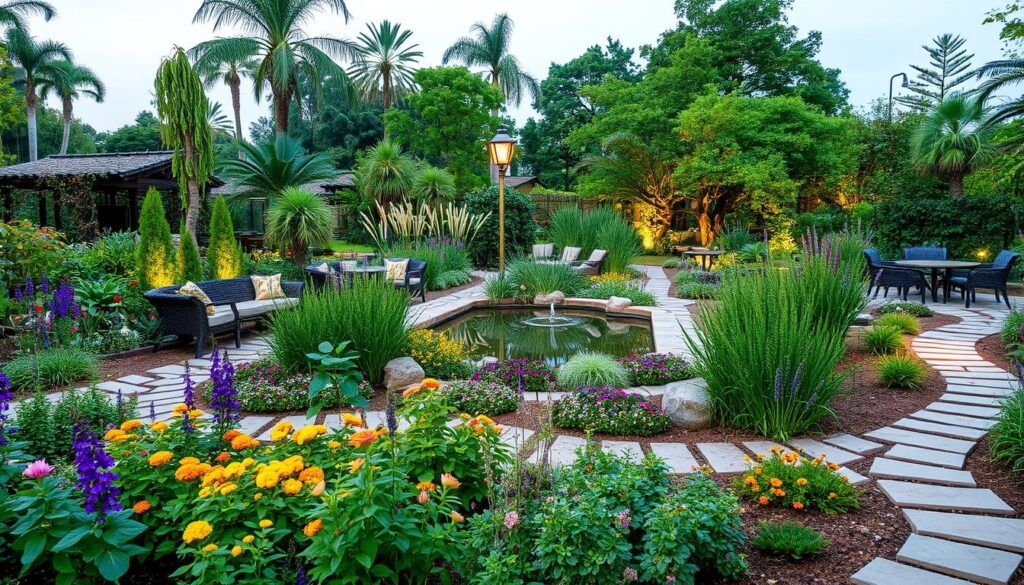
Engaging All Five Senses
Sound plays a key role in creating a calming atmosphere. Plants like bamboo and quaking grass add gentle rustling sounds that soothe the mind. For touch, include tactile favorites such as lamb’s ear and mosses. These textures invite interaction and make the space more engaging.
Here are some ideas to enhance your sensory experience:
- Place wind chimes in strategic spots for melodic sounds.
- Add night-blooming flowers like moonflowers for evening charm.
- Use textured pathway materials like gravel or smooth stones.
Creating a Tranquil Space
To make your garden more inclusive, consider adding braille plant labels. This thoughtful touch ensures everyone can enjoy the design. Research shows that therapeutic gardens can reduce stress and improve mental health. A case study on dementia-friendly layouts highlights their ability to provide comfort and stimulation.
By focusing on sensory elements, you can create a tranquil haven that’s both beautiful and functional. Whether you’re designing for relaxation or therapy, these tips will help you craft a space that engages all five senses.
14. Cottage Garden Style
Step into a world of charm and elegance with a timeless approach to your outdoor area. The cottage garden style is all about creating a romantic and colorful space that feels both natural and inviting. With its mix of flowers, herbs, and shrubs, this design brings a sense of nostalgia and beauty to any setting.
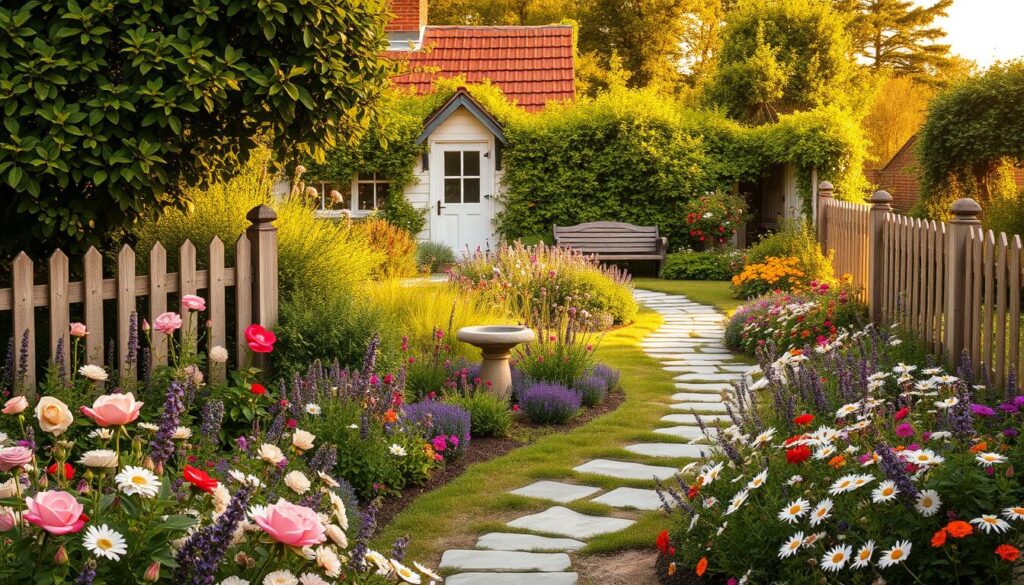
Romantic and Colorful Designs
Layering is key to achieving the quintessential cottage garden look. Start with bulbs like tulips and daffodils for early spring blooms. Add perennials such as foxgloves and hollyhocks for height and structure. Finish with shrubs like roses to create a lush, full appearance.
For a naturalistic feel, stagger bloom times to ensure continuous color throughout the seasons. Use a bloom time calculator to plan your planting. Vintage ornaments, like repurposed birdbaths or wrought iron gates, add a touch of history and personality to your space.
Deer-Resistant Plants
Protecting your plants from wildlife is essential. With the right selection, you can reduce deer damage by up to 82%. Choose deer-resistant options like lavender, rosemary, and yarrow. These not only deter deer but also add fragrance and texture to your layout.
Rabbit-proof flowering plants, such as marigolds and snapdragons, are another great addition. They’re hardy, vibrant, and less likely to be nibbled on by curious critters.
| Plant | Deer Resistance | Bloom Time |
|---|---|---|
| Lavender | High | Summer |
| Rosemary | High | Year-round |
| Yarrow | Moderate | Late Spring to Fall |
For inspiration, look to historic garden restorations. These projects often showcase the best of cottage garden principles, blending beauty with practicality. Whether you’re starting from scratch or updating an existing space, this style offers endless possibilities.
15. Pollinator-Friendly Gardens
Supporting local ecosystems while creating a vibrant outdoor area is easier than you think. By focusing on pollinators, you can attract bees, butterflies, and other beneficial insects. These creatures play a vital role in plant reproduction and maintaining biodiversity.
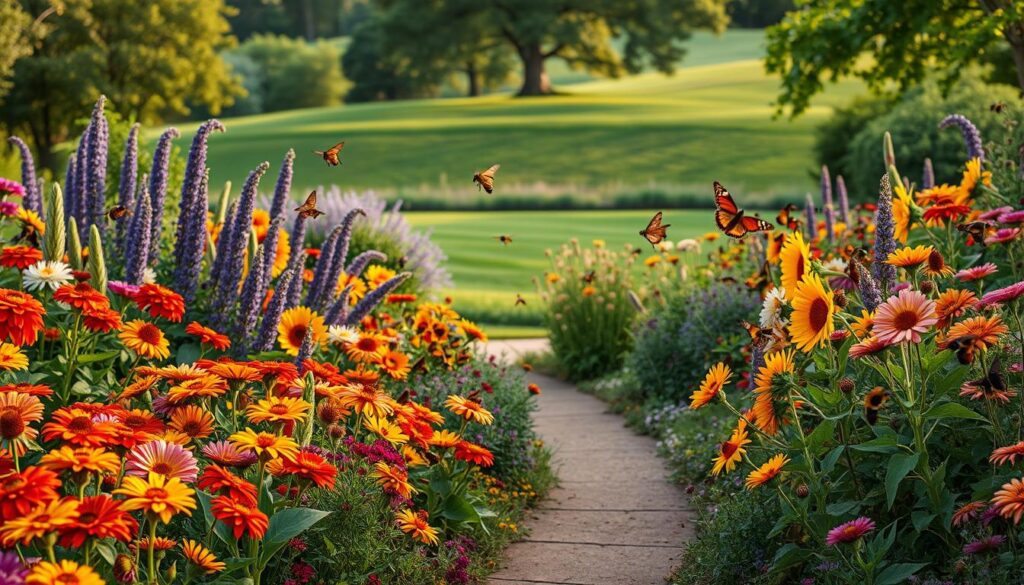
Attracting Bees and Butterflies
Native plants are a cornerstone of any pollinator-friendly space. They support four times more pollinators than non-native species. Essential features like mud puddles and bare ground provide habitats for butterflies and bees to thrive.
Here are some regional native milkweed varieties to consider:
- Common Milkweed (Midwest and Northeast)
- Swamp Milkweed (Southeast and Wetlands)
- Butterfly Weed (Southwest and Dry Regions)
Overwintering habitat preservation is another key step. Leave some leaf litter and plant stems intact during fall to provide shelter for insects. This simple practice can make a big difference in supporting local wildlife.
Low-Maintenance Designs
Creating a low-maintenance space doesn’t mean sacrificing beauty or functionality. Use butterfly host plant combinations like milkweed with asters or goldenrod. These pairings not only attract butterflies but also reduce the need for frequent upkeep.
Here are some pesticide alternatives to protect your pollinators:
- Neem oil for natural pest control
- Companion planting with marigolds
- Introducing beneficial insects like ladybugs
“A garden that supports pollinators is a garden that supports life.”
For continuous blooms, plan a sequence of flowering plants. Start with early bloomers like crocuses, followed by summer favorites like coneflowers, and end with fall stars like sedum. This ensures a steady food source for bees and butterflies throughout the year.
| Native Milkweed | Region | Pollinator Attraction |
|---|---|---|
| Common Milkweed | Midwest, Northeast | Monarch Butterflies |
| Swamp Milkweed | Southeast, Wetlands | Bees, Butterflies |
| Butterfly Weed | Southwest, Dry Regions | Monarchs, Swallowtails |
Consider joining a certified wildlife habitat program to further enhance your space. These programs provide guidelines and recognition for creating eco-friendly areas that support local wildlife. With thoughtful planning, your outdoor space can become a haven for pollinators and a source of pride for you.
16. Conclusion
Your outdoor space can become a reflection of your unique style and needs. From compact layouts to sprawling setups, the key is to focus on what works best for you. Start small with container plants or vertical setups to build confidence and grow from there.
Personalization is at the heart of every great design. Whether you’re drawn to eco-friendly options or vibrant blooms, your choices should align with your lifestyle. Upcoming trends like sustainable practices and pollinator-friendly setups offer exciting ways to enhance your area.
For further inspiration, explore resources like gardening blogs or community workshops. Ready to get started? Download our free planner to map out your vision. Remember, every great outdoor space begins with a single step—yours could be next!

